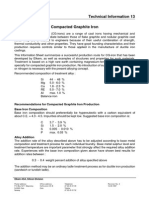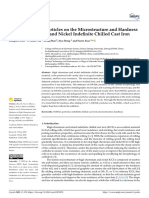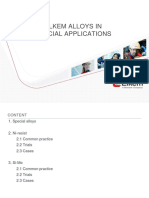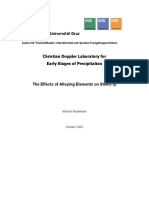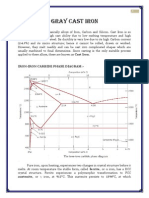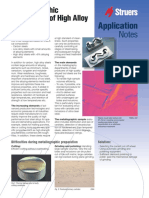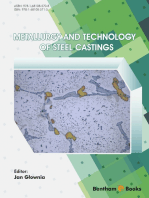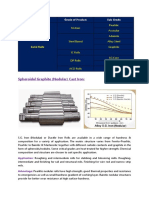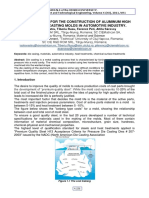Elkem 10 Tundish Cover Ladle Nodularization PDF
Elkem 10 Tundish Cover Ladle Nodularization PDF
Uploaded by
Anonymous iztPUhIiCopyright:
Available Formats
Elkem 10 Tundish Cover Ladle Nodularization PDF
Elkem 10 Tundish Cover Ladle Nodularization PDF
Uploaded by
Anonymous iztPUhIiOriginal Title
Copyright
Available Formats
Share this document
Did you find this document useful?
Is this content inappropriate?
Copyright:
Available Formats
Elkem 10 Tundish Cover Ladle Nodularization PDF
Elkem 10 Tundish Cover Ladle Nodularization PDF
Uploaded by
Anonymous iztPUhIiCopyright:
Available Formats
Technical Information 10
Tundish Cover Ladle Nodularization
Magnesium treatment for nodularization of ductile iron can be carried out by several different
treatment processes. The tundish cover ladle process will under most conditions, be a
convenient, effective and reliable process with good economy. The process provides good
consistency and high recoveries of magnesium over a wide range of treatment sizes. A well-
operated system will give between 60 – 80 % recovery of magnesium while the operating and
maintenance costs normally fall well below most other commercial processes. Tundish ladle
treatments also offer virtually no flare, about 90 % fume reduction, no metal splashing and
minimum carbon and temperature losses. The figure below shows an example of a tundish
cover ladle.
Figure 1: Schematic representation of a tundish cover ladle with dual alloy pockets.
Calculation of Filling Hole Dimensions
The following formula can be used to calculate the diameter of the tundish lid filling hole:
W
d = 0.07
t⋅h
Where d is the filling hole diameter in centimetres (cm), W is the liquid iron batch weight in
grams (g), t is the pouring time in seconds (s), and h is the ferrostatic height of metal in the
tundish basin in centimetres (cm). Note: h is the height of metal, not the height of the basin
itself.
Base metal sulphur contents should preferably not exceed 0.02% before treatment to ensure
maximum efficiency of the tundish ladle. If sulphur levels are higher, a desulphurizing step is
recommended prior to nodularization.
Elkem ASA, Silicon Division
Postal address: Office address: Telephone: Revision No. 2
P.O.Box 5211 Majorstua Hoffsveien 65 B 47 22 45 01 00 14.03.1997
N-0303 Oslo Oslo Telefax
Norway 47 22 45 01 52
Magnesium Alloy Selection and Addition
The tundish cover process may be used with most magnesium ferrosilicon alloys containing
between 3 to 12 % magnesium but generally alloys containing 4 – 6% Mg are used. Typically
an alloy of the following composition:
45% Si 5% Mg 1% Ca 1% RE max. 1% Al Bal. Fe
would be used to treat base iron composed of a mixture of steel scrap, pig iron and returns.
Alloy size grading of about 1 – 10 mm is most suitable for small treatments while sizes up to 4
– 35 mm are preferable for larger treatments. See Elkem Technical Information Sheet No. 20
for more details on selection of nodularizers in ductile iron.
The amount of alloy added usually lies between 1.2 and 1.8 weight % depending on the base
sulphur content, the metal temperature, the magnesium content of the alloy and the
consistency with which the process is carried out.
Cover Material Selection
It is recommended to use a cover material over the magnesium alloy in the reaction chamber
in order to obtain maximum treatment economy. The cover should retain the alloy in the
chamber for as long as possible before the reaction starts. Covers commonly consist of clean
steel plate or clippings of a grade similar to that used in the melt charges. Cast iron cover
plates can be cast from the spare metal left at the end of a cast thus avoiding the carbon
dilution due to the steel cover. However, the best results are obtained using a ferrosilicon alloy
as a cover material.
Example of Recovery Improvements
Figure 2: Schematic representation of recovery improvements as a function of sulphur content,
treatment temperature, and ladle design modifications. The initial case of 2.0 wt% addition rate
represents a situation with 0.03% S and 1520°C treatment temperature.
You might also like
- Frequently Used Line ItemsDocument4 pagesFrequently Used Line ItemsJamesTigh89% (9)
- A0130765H - Lab Report 1 PDFDocument14 pagesA0130765H - Lab Report 1 PDFFionaNo ratings yet
- BS en 12890 PatternsDocument32 pagesBS en 12890 PatternsAnonymous iztPUhIi100% (1)
- Din 5480-2Document2 pagesDin 5480-2Anonymous iztPUhIi50% (4)
- Sew 520Document8 pagesSew 520Anonymous iztPUhIiNo ratings yet
- MS - 003400 - 01 Rev 29Document22 pagesMS - 003400 - 01 Rev 29Arjun Prajapati100% (1)
- Cleen SteelDocument4 pagesCleen Steelcic6adaNo ratings yet
- Induction Furnace Vs Electric Arc FurnaceDocument1 pageInduction Furnace Vs Electric Arc FurnaceAnonymous iztPUhIi100% (1)
- Effective Filtration of Steel CastingsDocument40 pagesEffective Filtration of Steel CastingsWalter Hartwell WhiteNo ratings yet
- Hot Rolled Steel Sheet, Plate and Strip For Forming and Flanging Purposes According To IS 5986:2017Document9 pagesHot Rolled Steel Sheet, Plate and Strip For Forming and Flanging Purposes According To IS 5986:2017Mari MuthuNo ratings yet
- AMCOL - MCST - TR - HeviSand - Chromite - Double - Skin Defect - On - Heavy - Steel - Casting PDFDocument12 pagesAMCOL - MCST - TR - HeviSand - Chromite - Double - Skin Defect - On - Heavy - Steel - Casting PDFSUNDRAMNAGANo ratings yet
- Introduction Foundry IndustryDocument5 pagesIntroduction Foundry IndustryGUB PROJECTNo ratings yet
- 2014 - 11 - Basic Metallurgy Grey Iron PDFDocument34 pages2014 - 11 - Basic Metallurgy Grey Iron PDFfelipeNo ratings yet
- Feeding Risering For Steel Casting Design PDFDocument10 pagesFeeding Risering For Steel Casting Design PDFHusen TaufiqNo ratings yet
- Elkem 13 Compacted Graphite IronDocument2 pagesElkem 13 Compacted Graphite Ironmarcotulio123No ratings yet
- Home About Us Products Quality Control Representation Useful Links Contact UsDocument5 pagesHome About Us Products Quality Control Representation Useful Links Contact Ustushak mNo ratings yet
- Factors Influencing The Recovery and Addition of MagnesiumDocument4 pagesFactors Influencing The Recovery and Addition of Magnesiumarnaldorcr8646No ratings yet
- Crystals 12 00978Document9 pagesCrystals 12 00978irmaNo ratings yet
- Calcium in SteelDocument39 pagesCalcium in SteelStutee NandaNo ratings yet
- Investment Casting of Ductile IronsDocument5 pagesInvestment Casting of Ductile IronsSteve GreenNo ratings yet
- Nodular Cast Iron and Casting MonitoringDocument5 pagesNodular Cast Iron and Casting MonitoringSayyidah FarhanaNo ratings yet
- Wear Characteristics of Heat Treated Hadfield Austenitic Manganese Steel For Engineering ApplicationDocument15 pagesWear Characteristics of Heat Treated Hadfield Austenitic Manganese Steel For Engineering Applicationshrikant mishraNo ratings yet
- Manganese Steel: Hard, Abrasive and Unique Are Some of The Qualities Our Manganese Steel Can Be, What Do You Need?Document3 pagesManganese Steel: Hard, Abrasive and Unique Are Some of The Qualities Our Manganese Steel Can Be, What Do You Need?hhNo ratings yet
- Casting DefectsDocument5 pagesCasting DefectsNayeem pashaNo ratings yet
- MCM AllDocument7 pagesMCM AllPalanisamy RajaNo ratings yet
- Grey Iron A Unique MaterialDocument13 pagesGrey Iron A Unique MaterialmetkarthikNo ratings yet
- Sand CastingDocument46 pagesSand Castingjimmy mlelwaNo ratings yet
- Effect of Boron in D.I.Document2 pagesEffect of Boron in D.I.Sachin KumbharNo ratings yet
- Green Sand For HPMLDocument2 pagesGreen Sand For HPMLvivek1312No ratings yet
- Conformal Coating Curing and Drying Technical Bulletin Apr 09Document2 pagesConformal Coating Curing and Drying Technical Bulletin Apr 09Lee Hitchens100% (1)
- 2014 - 11 - Elkem Alloys in Special ApplicationsDocument27 pages2014 - 11 - Elkem Alloys in Special Applicationsfelipe100% (1)
- 2014 11 NiResistDocument12 pages2014 11 NiResistfelipeNo ratings yet
- Manganese, Sulfur and Manganese-Sulfur Ratio Effects in Gray Cast IronDocument30 pagesManganese, Sulfur and Manganese-Sulfur Ratio Effects in Gray Cast IronNetoNo ratings yet
- DISA TestDocument75 pagesDISA Testtanto_deep_15No ratings yet
- Choi - Effect of Welding Parameters On Tungsten Carbide - Metal Matrix Composites Produced by GMAWDocument22 pagesChoi - Effect of Welding Parameters On Tungsten Carbide - Metal Matrix Composites Produced by GMAWSimNo ratings yet
- The Effects of Alloying Elements On Steels 1Document36 pagesThe Effects of Alloying Elements On Steels 1Common ManNo ratings yet
- Effect of Niobium On The As-Cast Microstructure of Hypereutectic High Chromium Cast IronDocument4 pagesEffect of Niobium On The As-Cast Microstructure of Hypereutectic High Chromium Cast IronMatheus BoligonNo ratings yet
- Study of Pinholes Genesis in Iron Castings: Archives of Foundry EngineeringDocument6 pagesStudy of Pinholes Genesis in Iron Castings: Archives of Foundry EngineeringFabiano MonteiroNo ratings yet
- The Relationship Between Boron Content and Crack Properties in FCAW Weld MetalDocument6 pagesThe Relationship Between Boron Content and Crack Properties in FCAW Weld MetalVizay KumarNo ratings yet
- 05 Lustrous Carbon Incl PDFDocument2 pages05 Lustrous Carbon Incl PDFbvphimanshuNo ratings yet
- Defects and Rejection AnalysisDocument61 pagesDefects and Rejection Analysissnehal sobarad100% (1)
- Chunky GraphiteDocument16 pagesChunky GraphitesachinguptachdNo ratings yet
- Foundry Bhel1Document7 pagesFoundry Bhel1Charu MallNo ratings yet
- Troubleshooting and Prevention of Cracking in Induction Hardening of Steels - Lessons Learned Part 2Document8 pagesTroubleshooting and Prevention of Cracking in Induction Hardening of Steels - Lessons Learned Part 2Rajesh GNo ratings yet
- Tips For Auditing Your Green Sand SystemDocument10 pagesTips For Auditing Your Green Sand Systemcrazy dNo ratings yet
- Gas Fron Green SandDocument13 pagesGas Fron Green Sandjose.figueroa@foseco.comNo ratings yet
- Ni ResistDocument2 pagesNi ResistAslan Alp0% (1)
- AntiSegregation HopperDocument5 pagesAntiSegregation Hoppermecaunidos7771No ratings yet
- Casting DefectsDocument7 pagesCasting DefectsNazrul Abdul LatiffNo ratings yet
- 5 MgFeSiDocument40 pages5 MgFeSiBruno Eduardo Coelho100% (2)
- AFS Thermal Analysis of CupsDocument12 pagesAFS Thermal Analysis of Cupsyash_ganatraNo ratings yet
- Cast Iron PlasticityDocument0 pagesCast Iron Plasticityjebrahimi2003No ratings yet
- Evaporative Pattern Casting Epc PDFDocument2 pagesEvaporative Pattern Casting Epc PDFLauraNo ratings yet
- CarburizerDocument28 pagesCarburizerWalton BangladeshNo ratings yet
- Certified Reference Materials (CRM) : Csir-National Metallurgical Laboratory JAMSHEDPUR-831007, INDIADocument6 pagesCertified Reference Materials (CRM) : Csir-National Metallurgical Laboratory JAMSHEDPUR-831007, INDIAShiv PandeyNo ratings yet
- Investment CastingDocument8 pagesInvestment Castingbandit96No ratings yet
- Magnesium Casting Technology For Structural ApplicationsDocument21 pagesMagnesium Casting Technology For Structural ApplicationsJinsoo KimNo ratings yet
- Project ReportDocument54 pagesProject ReportRakesh Kumar Munda100% (1)
- Encyclopedia of Iron, Steel, and Their Alloys - Investment CastingDocument20 pagesEncyclopedia of Iron, Steel, and Their Alloys - Investment CastingPranoy BaruaNo ratings yet
- 227-02 Application of Sivex Foam FiltersDocument6 pages227-02 Application of Sivex Foam Filtersnagola10No ratings yet
- MSI DC 01 FosecoDocument4 pagesMSI DC 01 FosecoVivek Shrivastava100% (1)
- Struers Application Note - Metallographic Preparation of High Alloy Tool SteelDocument6 pagesStruers Application Note - Metallographic Preparation of High Alloy Tool SteelCan ERTANNo ratings yet
- Elkem 10 Tundish Cover Ladle NodularizationDocument2 pagesElkem 10 Tundish Cover Ladle Nodularizationmarcotulio123No ratings yet
- 03 - An Alloy Design Concept For Better Matching of Strength and Toughness in Pipeline SteelDocument7 pages03 - An Alloy Design Concept For Better Matching of Strength and Toughness in Pipeline SteelŞarîngă George AlexandruNo ratings yet
- Spheroidal Graphite (Nodular) Cast Iron:: Product Type Grade of Product Sub GradeDocument5 pagesSpheroidal Graphite (Nodular) Cast Iron:: Product Type Grade of Product Sub GradeAnonymous iztPUhIiNo ratings yet
- Astm A 297Document3 pagesAstm A 297friasdelacruz75% (4)
- BS 3100 1991Document20 pagesBS 3100 1991Anonymous iztPUhIi100% (1)
- Welding Solutions: Selecting The Proper PositionerDocument1 pageWelding Solutions: Selecting The Proper PositionerAnonymous iztPUhIiNo ratings yet
- BS 3100 1991Document20 pagesBS 3100 1991Anonymous iztPUhIi100% (1)
- Chance in BballDocument12 pagesChance in BballAnonymous iztPUhIiNo ratings yet
- Process Knowledge in FoundriesDocument23 pagesProcess Knowledge in FoundriesAnonymous iztPUhIiNo ratings yet
- Working With The Cold Box ProcessDocument21 pagesWorking With The Cold Box ProcessAnonymous iztPUhIiNo ratings yet
- Steel Castings in Architecture and Engineering: Hans SchoberDocument5 pagesSteel Castings in Architecture and Engineering: Hans SchoberAnonymous iztPUhIiNo ratings yet
- 1512 07208Document11 pages1512 07208Anonymous iztPUhIiNo ratings yet
- ISO 1940-2-1997 Mechanical VibDocument20 pagesISO 1940-2-1997 Mechanical VibJavad Monfared100% (4)
- ISO 1940-2-1997 Mechanical VibDocument20 pagesISO 1940-2-1997 Mechanical VibJavad Monfared100% (4)
- Solovastru Ioan L1Document7 pagesSolovastru Ioan L1Anonymous iztPUhIiNo ratings yet
- GHS Implementation in ASEAN and Asia Pacific - GHS Training - 28feb2017Document18 pagesGHS Implementation in ASEAN and Asia Pacific - GHS Training - 28feb2017yosepNo ratings yet
- Adobe Scan 19-Dec-2022Document25 pagesAdobe Scan 19-Dec-2022Saurabh Kumar PatelNo ratings yet
- Molecules From Atoms: 3.012 Fund of Mat Sci: Bonding - Lecture 10Document22 pagesMolecules From Atoms: 3.012 Fund of Mat Sci: Bonding - Lecture 10Yacine BenzNo ratings yet
- An Overview of Sample Preparation Procedures For LC-MS Multiclass Antibiotic Determination in Environmental and Food SamplesDocument27 pagesAn Overview of Sample Preparation Procedures For LC-MS Multiclass Antibiotic Determination in Environmental and Food SamplesHenry PalandengNo ratings yet
- National Ambient Air Quality StandardsDocument3 pagesNational Ambient Air Quality StandardsAji GumelarNo ratings yet
- Project 2 ReportDocument12 pagesProject 2 Reportapi-742556905No ratings yet
- Chapter Two Literature Review 2.1Document6 pagesChapter Two Literature Review 2.1Edith Omoze Arughu-JosephNo ratings yet
- Powder Technology: Issa M. El-Nahhal, Jamil K. Salem, Sylvia Kuhn, Talaat Hammad, Rolf Hempelmann, Sara Al BhaisiDocument8 pagesPowder Technology: Issa M. El-Nahhal, Jamil K. Salem, Sylvia Kuhn, Talaat Hammad, Rolf Hempelmann, Sara Al BhaisiardhiNo ratings yet
- Fibre To Yarn Dyeing - 2 PDFDocument47 pagesFibre To Yarn Dyeing - 2 PDFপ্রমিত সরকারNo ratings yet
- ReviewDocument40 pagesReviewRossana VerdidaNo ratings yet
- ConSem 2014 - Justin Kretzmar Rev 2 (Compressed) .PPSXDocument25 pagesConSem 2014 - Justin Kretzmar Rev 2 (Compressed) .PPSXMulyono WraharjoNo ratings yet
- Chemistry of LipidsDocument30 pagesChemistry of Lipidszahid mahmoodNo ratings yet
- Rates RadionicaDocument32 pagesRates RadionicaGonzalo Daniel Llarrull Batista100% (2)
- Practical Pyrotechnics by Wouter VisserDocument173 pagesPractical Pyrotechnics by Wouter Vissere_d_n_a50% (4)
- Steam Turbine MaintenanceDocument3 pagesSteam Turbine Maintenancedreamboy87No ratings yet
- Ultimate Guide To Cast Iron WeldingDocument16 pagesUltimate Guide To Cast Iron WeldingMohamedNo ratings yet
- Msds of LiOHDocument6 pagesMsds of LiOHmunawar786No ratings yet
- Monday 20 May 2019 - Morning: AS Level Chemistry ADocument12 pagesMonday 20 May 2019 - Morning: AS Level Chemistry Asemirah anthonyNo ratings yet
- 2nd Grading. Gen BioDocument3 pages2nd Grading. Gen BioAngelyne PotencianoNo ratings yet
- XXXXXXXXXXXXXXXXXXXXXXXXXXXX Process Validation Protocol (Capsule)Document25 pagesXXXXXXXXXXXXXXXXXXXXXXXXXXXX Process Validation Protocol (Capsule)Navdeep ChaudharyNo ratings yet
- Ped Medications Chapter 11Document51 pagesPed Medications Chapter 11allisonNo ratings yet
- Autoclaved Aerated ConcreteDocument4 pagesAutoclaved Aerated ConcreteArunima DineshNo ratings yet
- WHMIS Quiz - TAMloginDocument2 pagesWHMIS Quiz - TAMloginsethtwardNo ratings yet
- Balancing Chemical EquationsDocument32 pagesBalancing Chemical EquationsAple RigorNo ratings yet
- Fire HazardDocument20 pagesFire HazardJohn Rhimon Abaga Gelacio100% (2)
- Sulfuric Acid Sulfur Storage Tank InspectionsDocument36 pagesSulfuric Acid Sulfur Storage Tank InspectionsMohamed ZezoNo ratings yet
- Section 2: Signal Transmission Between The NeuronsDocument123 pagesSection 2: Signal Transmission Between The NeuronsAna Crigan VlasNo ratings yet
- Chem Xi Chap 5 Worksheet 1Document4 pagesChem Xi Chap 5 Worksheet 1ayesha nazNo ratings yet














